
Each year brings breakthroughs, but 2025 already feels different. Staying informed isn’t optional—it’s survival. 2025 is already shaping up to be a defining year. Agentic AI is moving from concept to application, immersive spatial computing is breaking into the mainstream, and next-generation green energy is rewriting industrial playbooks. Innovation is coming so fast that a casual scroll through headlines just won’t cut it.
The real challenge today isn’t finding information; it’s filtering signal from noise. Every day brings new breakthroughs, funding rounds, surprise pivots, product launches, and innovations that ripple across industries. With thousands of tech news sites and blogs out there, finding the right sources can feel like searching for a needle in a haystack. To make sense of it all, you need more than hype cycles and reposted press releases—you need trusted sources that deliver both speed and context.
That’s why we put together this definitive list of the Top 10 Tech News Sites to Follow in 2025. Whether you’re a founder, investor, operator, or an avid observer, these platforms will help you cut through the chatter, stay ahead of emerging trends, and understand the forces shaping our digital future.
How We Picked the Best Tech News Sites for 2025
Not every tech publication earns a spot on this list. We looked for outlets that consistently deliver real value, not just recycled headlines. Each site was selected based on four key criteria:
-
Consistency: Regular publishing with clear editorial standards. These sites don’t vanish for weeks at a time — they show up daily with meaningful updates.
-
Authority: A proven ability to shape conversations. We prioritized publications that break stories, influence adoption through trusted reviews, or provide reporting that informs markets and policy.
-
Clarity: Writing that gets to the point. No fluff, no PR jargon — just sharp analysis that explains what’s at stake.
-
Usefulness: Coverage that helps readers make better decisions, whether that’s choosing a product, tracking investments, hiring talent, or shaping strategy.
Best Tech Blogs and News Websites
1. The Verge

Focus: Consumer tech, culture, reviews, and feature storytelling
Why it matters in 2025: When The Verge launched in 2011, it redefined what a tech site could be. Its mix of sharp writing, bold visuals, and long-form features gave it a magazine feel in a digital world dominated by quick takes. Over a decade later, The Verge is still one of the most influential voices shaping consumer tech coverage.
What you’ll get: A blend of breaking news, hands-on gadget reviews, cultural commentary, and design-driven storytelling. A Verge review can boost or sink enthusiasm for a new device, thanks to its credibility with consumers. Beyond reviews, its feature pieces explore how technology intersects with politics, entertainment, and design — explaining not just what a product does, but how it affects the way we live and work. Its podcasts and video coverage add multimedia depth, making it one of the most modern-feeling tech outlets on this list.
Best for: Readers who want more than spec sheets — those who care about how design, culture, and technology fit together. For founders and marketers, The Verge is worth following because it influences mainstream perception.
Pro tip: Pay attention to how The Verge frames product launches. The tone they set often ripples across social media and can shape consumer adoption more than you’d expect.
2. Engadget
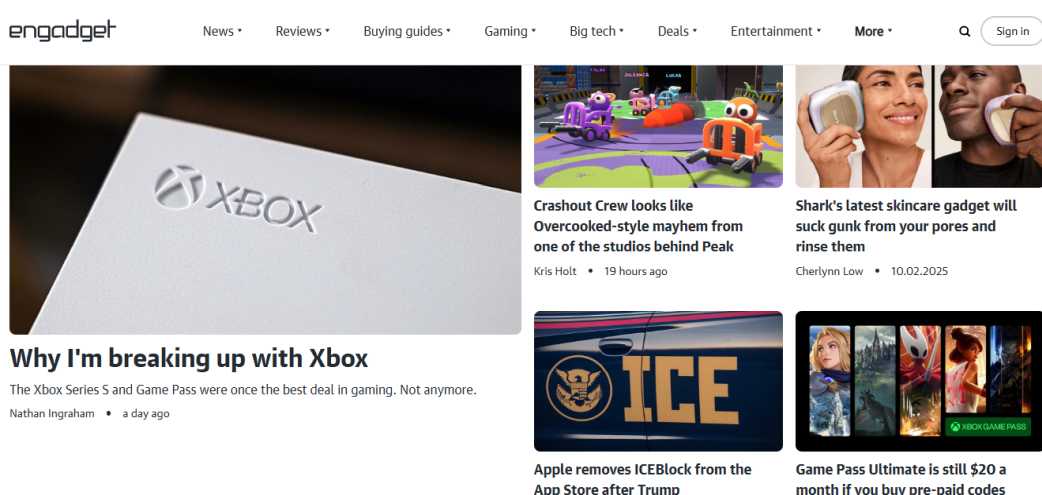
Focus: Consumer electronics, product reviews, live event coverage
Why it matters in 2025: Founded in 2004, Engadget started as a gadget blog and evolved into one of the most trusted consumer electronics outlets worldwide. Its reputation is built on consistency — thorough reviews, reliable product coverage, and live event reporting that has kept it relevant through nearly two decades of rapid change.
What you’ll get: Detailed, hands-on reviews of smartphones, laptops, wearables, gaming systems, and more. Engadget also excels at live coverage from global events like CES and Apple’s product launches. Its video content adds another layer, giving readers a chance to see devices in action before they buy.
Best for: Tech enthusiasts and everyday consumers alike. If you’re deciding what to buy or just want to stay informed on the latest gadgets, Engadget is still one of the most practical and reliable sources in 2025.
Pro tip: Use Engadget as a barometer for consumer perception. Its reviews and event coverage often reflect what average buyers will care about most, which is invaluable if you’re a founder trying to reach mainstream audiences.
3. Wired

Focus: Technology, science, policy, culture
Why it matters in 2025: AI isn’t just a feature anymore; it’s policy, labor, education, and national strategy. That’s Wired’s home turf. While daily blogs chase what happened this morning, Wired asks what it means six months from now. You’ll find reporting on surveillance, climate tech, digital rights, cybersecurity, and the social effects of automation — the topics that outlast a product cycle.
What you’ll get: Long-form features with reporting depth, smart explainers on technical shifts, and consistent coverage of the political and ethical fights around technology. When a debate breaks out over data use, algorithmic bias, or the trade-offs of electrification, Wired usually has the most readable, sourced piece in the room.
Best for: Readers who want perspective, not only updates. Founders thinking beyond launch day, policy-minded operators, and anyone who needs to brief a team on “why this trend actually matters.”
Pro tip: Use Wired pieces as the backdrop for strategy docs or investor memos. They’re strong at framing second-order effects — the part most pitch decks gloss over.
4. TechCrunch
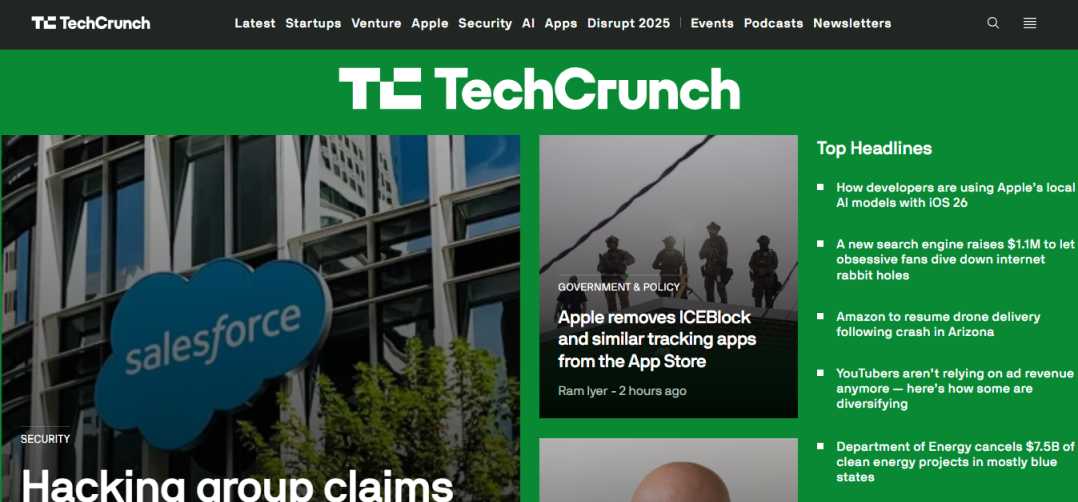
Focus: In-depth reporting on technology and startups, venture capital, and the future of innovation.
Why it matters in 2025: For startup momentum and investor attention, TechCrunch still sets the pace. It’s where founders announce rounds, where investors float theses, and where the rest of the ecosystem decides whether a category has legs. Even with funding news now spread across dozens of outlets, TechCrunch remains the most-watched for venture flows.
What you’ll get: Daily funding coverage from seed through pre-IPO, product launch write-ups, founder and investor interviews, deal terms when companies disclose them, and steady beats across fintech, AI tools, dev platforms, healthtech, climate, and more. Disrupt and Startup Battlefield continue to be launch pads — not just events, but deal-making venues where coverage and capital meet.
Best for: Builders tracking competitor momentum, investors scanning for signals, and operators who need a daily pulse on where money is moving. If you care about who raised, who hired, and who’s shipping, you’ll find it here first or fastest. TechCrunch is known for its Disrupt conference.
Pro tip: Don’t just read the announcement — read the pattern. Note which sectors show up repeatedly over a month, which geographies are gaining heat, and which investors cluster around a thesis. That meta-signal is where the edge lives.
5. TechStartups
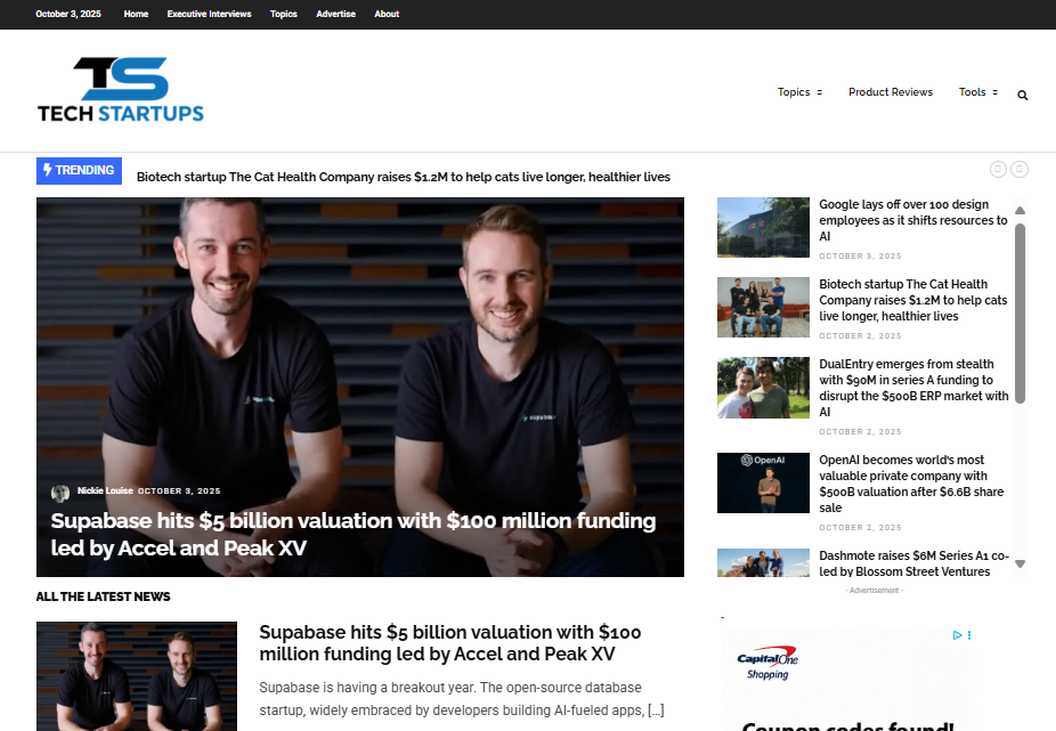
Focus: Technology startups, startup funding, underdog founders, emerging tech, and global innovation
Why it matters in 2025: Most tech blogs chase the same high-profile names — unicorns, mega-rounds, and Silicon Valley giants. TechStartups was created to do the opposite. Since launching in 2017, it has carved out a mission to spotlight underdog founders and early-stage startups often overlooked by mainstream outlets. That positioning has made it a trusted source for readers who want more than copy-paste press releases.
What you’ll get: Daily funding news across all stages, but always with context. Instead of stopping at “Startup X raised $20 million,” TechStartups breaks down why the raise matters — what problem the company is tackling, how it fits into broader market shifts, and what it signals for the sector. Coverage stretches far beyond Silicon Valley, bringing attention to fintech in Africa, AI startups in Europe, or healthtech founders building outside the coastal U.S. bubble.
Best for: Founders and investors who want visibility into global innovation, not just the usual circles. It’s also valuable for students and operators who want to track how new technologies and business models are emerging in less-saturated markets.
Pro tip: Watch TechStartups for pattern recognition. Because it consistently covers smaller and earlier-stage companies, it often spots themes before they hit mainstream press — giving you a head start on trends that will dominate later.
6. Gizmodo

Focus: Gadgets, science, politics, and cultural critique
Why it matters in 2025: Gizmodo has always been a little rebellious. Launched in 2001, it quickly built a reputation for sharp, witty coverage that didn’t stick to safe ground. Unlike blogs that stick to product launches and funding news, Gizmodo dives headfirst into the politics, science, and culture wrapped around technology.
What you’ll get: Expect gadget reviews and science reporting alongside climate change analysis, surveillance deep-dives, and sharp takes on tech policy. Gizmodo isn’t afraid to challenge the industry or inject opinion, which makes it one of the most distinct voices in the tech ecosystem. While other outlets aim for polished neutrality, Gizmodo leans into personality — and that’s exactly why its stories get traction.
Best for: Readers who want news with an edge. If you’re looking for straightforward product specs, you’ll go elsewhere. But if you want cultural context, critique, and commentary with bite, Gizmodo delivers.
Pro tip: Watch how Gizmodo covers politically charged tech issues (privacy, climate, misinformation). Its framing often sets the tone for how these debates unfold in mainstream media.
7. Mashable
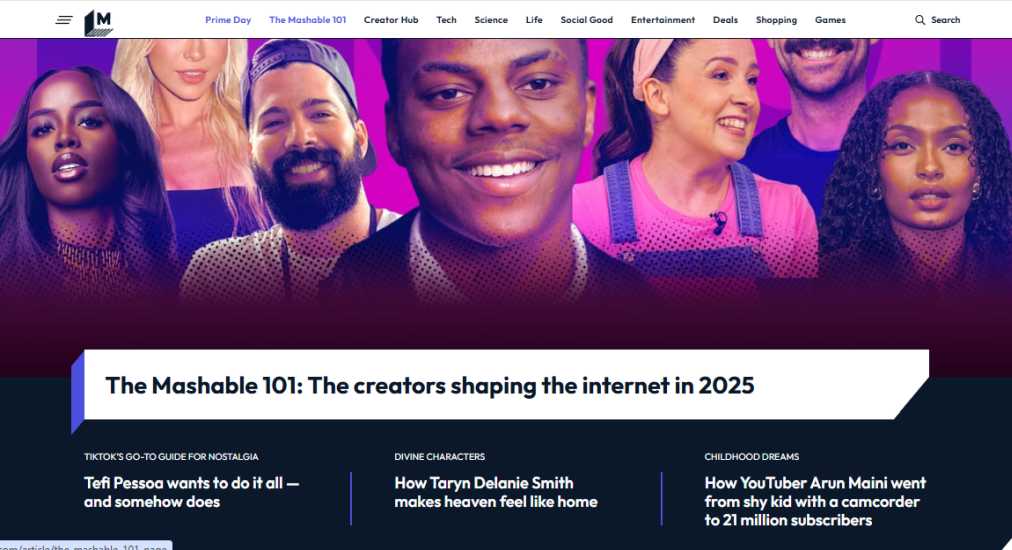
Focus: Tech, digital culture, entertainment, social media
Why it matters in 2025: While some outlets chase unicorns and funding rounds, Mashable has stayed focused on explaining technology to a wider audience. Launched in 2005 by Pete Cashmore, it grew from a solo blog into one of the most widely recognized digital media brands covering the crossroads of tech, culture, and entertainment.
What you’ll get: A steady mix of gadget news, app reviews, streaming updates, and internet culture trends. Mashable covers what’s happening in the tech world and shows how it spills into the way people talk, shop, and share online. In 2025, it’s still one of the best places to understand how platforms like TikTok or X (formerly Twitter) shape public conversations, how entertainment and tech collide, and which new gadgets are gaining mainstream attention.
Best for: Everyday readers who want approachable tech coverage without wading through venture capital jargon. It’s also a useful resource for marketers, product designers, and founders who want to understand cultural adoption, not just technical specs.
Pro tip: Watch Mashable’s coverage of digital culture. Startups often underestimate how internet memes, creator communities, or viral trends can influence product adoption. Mashable spots those shifts early.
8. Recode (Vox Media)
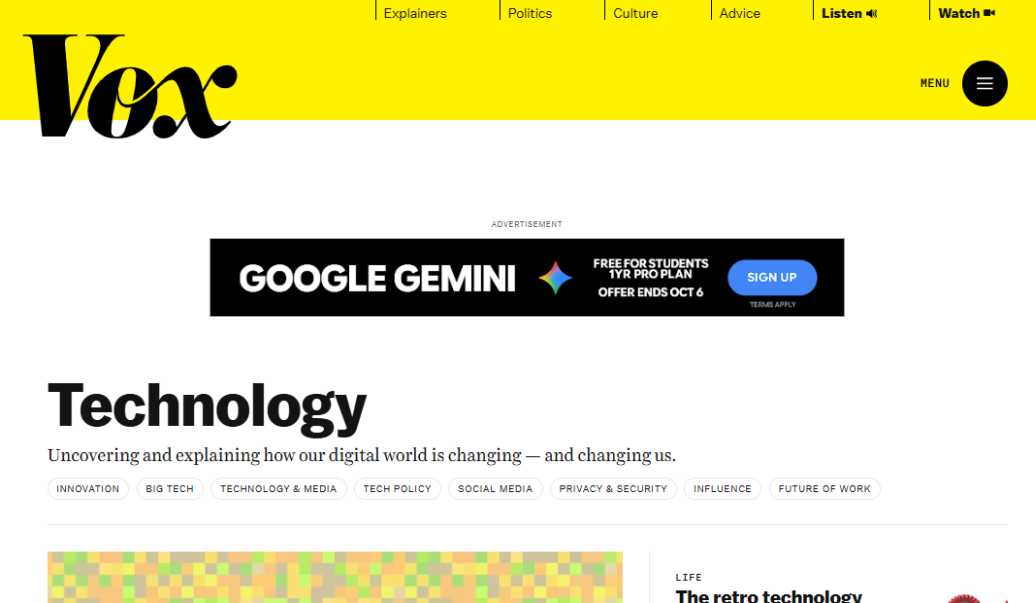
Focus: Big Tech, regulation, and power moves
Why it matters in 2025: Recode was built to hold Silicon Valley accountable at a time when most coverage leaned toward hype. Founded by Kara Swisher in 2014, the site quickly became known for exposing power dynamics rather than just writing up product releases. Today, under Vox Media, it continues to sharpen its focus on the companies and executives making the decisions that ripple across the global economy.
What you’ll get: Sharp analysis of how tech giants like Apple, Meta, Google, and Amazon are influencing everything from privacy regulation to antitrust lawsuits. You’ll also find coverage of the relationships between Washington and Silicon Valley — how lobbying, policy fights, and corporate strategy intersect. Recode’s podcasts, many still tied to Swisher’s voice, remain some of the most listened-to in the industry, offering blunt interviews with CEOs, lawmakers, and industry veterans.
Best for: Readers who want to understand not just what Big Tech is doing, but why. If you’re trying to anticipate regulatory headwinds, track executive power plays, or brief your team on how Washington politics collide with corporate agendas, Recode delivers the kind of context most outlets gloss over.
Pro tip: Follow Recode when you’re crafting a strategy in regulated industries like finance, healthcare, or AI. Its reporting often foreshadows moves that will affect startups long before rules are written into law.
9. CNET

Focus: Consumer tech reviews, buying guides, practical explainers
Why it matters in 2025: Founded in 1994, CNET has long been the go-to site for consumers trying to make sense of technology purchases. While some blogs thrive on breaking news or cultural analysis, CNET has built its reputation on trust. Millions of readers come to it not for hype, but for practical guidance that helps them decide what to buy.
What you’ll get: In-depth product reviews, hands-on testing, buying guides, and clear side-by-side comparisons. Whether you’re choosing between two laptops, debating a new smartphone upgrade, or trying to understand the latest EV features, CNET delivers breakdowns that are accessible and actionable. Its how-tos and explainer content also help readers navigate software updates, streaming services, and smart home setups.
Best for: Everyday consumers looking for guidance before making purchases, but also for product managers, marketers, and founders who want to understand how mainstream buyers evaluate technology.
Pro tip: Read CNET reviews to see how products are framed to the average consumer. Startups often get lost in technical jargon, but CNET shows you the language that resonates with real buyers — a valuable lens if you’re positioning your own product.
10. VentureBeat

Focus: Artificial intelligence, enterprise technology, and gaming
Why it matters in 2025: VentureBeat may not have the brand recognition of TechCrunch or Wired, but it has become indispensable in specific niches. Since its launch in 2006, it has steadily built authority around artificial intelligence, enterprise technology, and gaming — three areas now central to the global economy.
What you’ll get: Detailed reporting on AI adoption, business use cases, and infrastructure. VentureBeat’s dedicated AI channel is a must-read for executives evaluating new platforms and tools, and its Transform events bring together some of the sharpest minds in the industry. On the gaming side, its coverage goes beyond launches and reviews to dig into the economics of esports, VR/AR innovation, and how gaming studios are evolving business models.
Best for: Executives, product leaders, and investors who want to understand how transformative technologies are being applied at scale. It’s also a strong resource for anyone tracking the business of gaming or enterprise adoption of AI.
Pro tip: Use VentureBeat to gauge early market signals in AI and enterprise adoption. Its coverage often highlights B2B startups and partnerships before they hit wider press, giving you a head start on shifts in enterprise demand.
Hacker News (Special Mention)
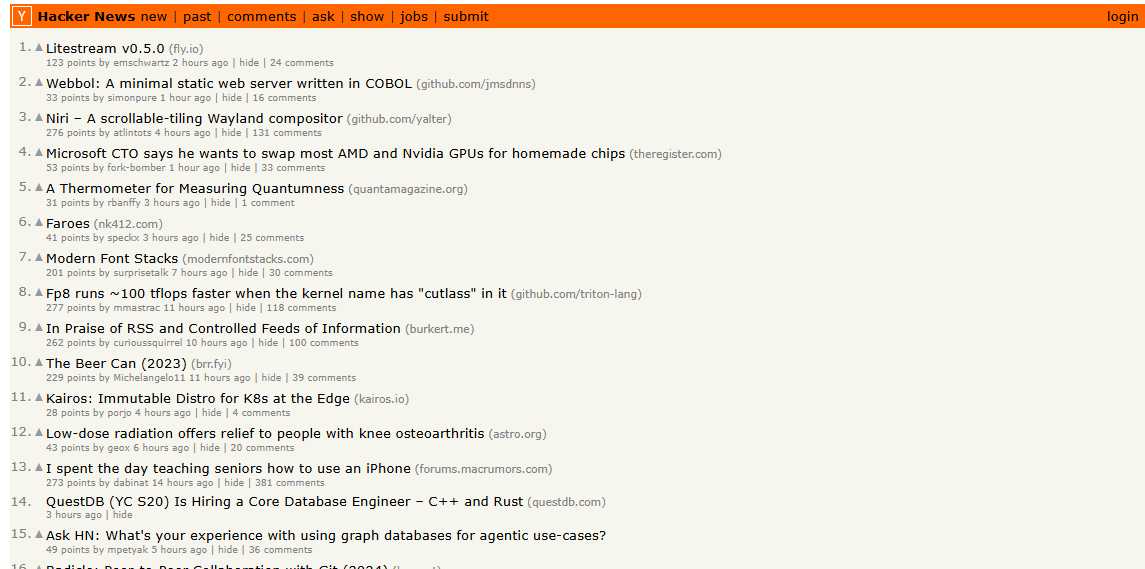
Focus: Community-driven discussions, startup launches, and early tech signals
Why it matters in 2025: Hacker News isn’t a traditional media outlet — it’s a community bulletin board where some of the most influential conversations in tech happen first. Run by Y Combinator, the site has been a daily destination for founders, engineers, and investors for over a decade. It’s often where emerging technologies, niche products, and bold ideas get surfaced before mainstream media notices.
What you’ll get: A constant stream of links, discussions, and firsthand insights from builders. Startup founders often share launches directly with the community, sparking detailed technical debates, early product feedback, and unexpected exposure. Hacker News threads frequently shape narratives that later get picked up by publications like TechCrunch and The Verge.
Best for: Founders, engineers, and operators who want to catch trends early, cut through PR filters, or get honest feedback from a highly technical audience.
Pro tip: Don’t just read the front page — watch the “Show HN” section, where makers post their projects for the first time. Many breakout startups got their earliest traction right there.
Final Thoughts
Technology doesn’t stand still — and neither do the blogs that cover it. From giants like Wired and TechCrunch to underdog-focused outlets like TechStartups, each of these blogs fills a different role in helping readers keep pace.
Some help explain the big picture, like Wired. Others track venture flows, like TechCrunch. A few shape consumer perception, like The Verge and Engadget. And some, like TechStartups, give a voice to innovators building far from Silicon Valley’s spotlight.
In 2025, following these blogs isn’t optional if you want to stay competitive — it’s the price of admission.
Don’t want to juggle 10 tabs every day? Subscribe to TechStartups Daily Newsletter and follow us on X for curated updates straight to your inbox.
Frequently Asked Questions (FAQs)
1. Which tech blog is best in 2025?
It depends on your needs. Wired is best for deep analysis, TechCrunch for startup funding, TechStartups for underdog founders, CNET for consumer reviews, and VentureBeat for AI and enterprise insights.
2. What’s an example of a technology blog?
Sites like TechCrunch, The Verge, and TechStartups are prime examples — they combine reporting, reviews, and analysis on startups, gadgets, and industry trends.
3. How often should I read tech blogs?
Daily, if you want to keep up with funding and product news. Weekly roundups and monthly reports are best if you prefer trend spotting without information overload.
4. Can I rely on tech blogs for business or career decisions?
They’re a strong starting point for spotting trends and opportunities, but they should complement deeper research, due diligence, and professional advice.
5. Is starting a tech blog in 2025 still worth it?
Yes — but only if you can differentiate. The space is crowded, so you’ll need a clear niche, consistent publishing, and a voice that stands out.
6. Which blogs are best for product reviews?
CNET and Engadget remain the gold standards for consumer gadgets, with Gizmodo and The Verge also offering influential takes.
7. Which blogs go beyond Silicon Valley?
TechStartups is dedicated to covering global founders outside the Bay Area. Tech in Asia and other regional outlets also provide strong non-U.S. coverage.
8. How do I use these blogs strategically?
Founders can track competitors and spot early market signals. Investors can see where capital is flowing. Consumers can make smarter purchase decisions. Each blog offers a lens — together, they give you a full picture.




